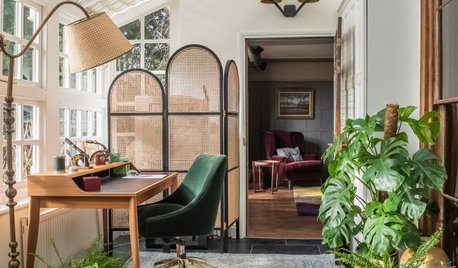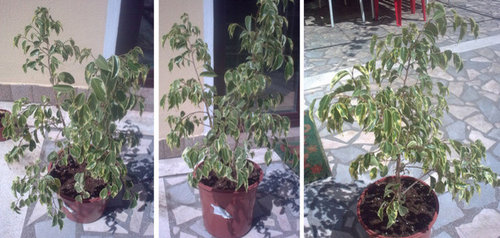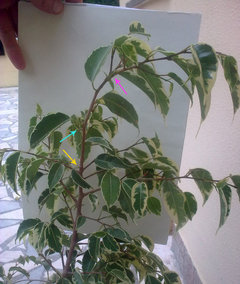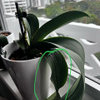Ficus in a Pot - How to Prune to grow tall?
Johy
9 years ago
Featured Answer
Comments (24)
Johy
9 years agolast modified: 9 years agoRelated Discussions
Ficus Retusa - Specifics on Growing/Potting/Soil Mix/Pruning
Comments (4)Who told you they shouldn't be in direct sun? They LOVE the sun! As long as there's also some humidity available. They do like to grow in a pot that looks smaller than you'd normally think, so don't go overboard, but you should first (regardless of anything else) take it out of the pot and check for routbound-ness, and if it's bad, then trim off 1/4-1/3 of existing roots and repot into a fast draining gritty soil mix (no peat!). Now if you want it to grow bigger, don't trim the roots, but just loosen them enough to slightly spread the ball without undoing it all. Size of pot can certainly be somewhat wider to accommodate new aerial root spread, but how deep it is will be up to you. What do you mean "the greater the ... leaves'? And BTW, basic information on bonsai doesn't mean much, as trees vary tremendously in their needs. I can't look at your picture because when I click on the link a bunch of thumbnails come up with lots of plants (and parts of same) but no I.D., just stuff underneath the pix - one plain one of which would definitely help here, with some little thing next to it for relative size gauging....See MorePruning a Ficus
Comments (5)You haven't shown us a photo of the base of your plant, so it's impossible to tell if you actually have two plants or one with main stems starting below the soil line. Unless the potting mix it is (or they are) in looks very bad, I would wait until spring to repot. If there are clearly two root systems you could separate them then. I have a 25-year-old fiddle leaf fig that has several stems at the soil line. Some are from cuttings I planted in the same pot, but others arose spontaneously from roots of the original plant. I could separate them, but I prefer the bushy look. By the way, I saw your other question about marks and blemishes on your plant. My experience with ficus lyratas and elasticas is that they are very sensitive to such damage from the environment and even show damage from rough handling. The white stuff is usually sap that leaks from tiny wounds. The less you handle new growth, the better. This is especially true when they are inside in a semi dormant state. Another reason to wait until early summer to transplant or root prune....See MoreFicus Lyrata Air Layer - How long can new plant survive without pot?
Comments (4)The main root mass is still supplying water & nutrients to the top via the xylem, and that burden shifts to the roots produced by layering at the point in time when the layer is separated; so, some care should be taken to ensure things don't go awry, but by and large you should be fine for at least a week or two, doing nothing more than keeping the layering medium moist. Al...See MoreAdvice for how to continue to prune and shape ficus lyrata/fiddle leaf
Comments (0)The last time I pruned was 5/2018 and I unfortunately skipped last season and now branches A and B are growing a lot faster than the others bc they are closer to the sunlight which is a skylight. Branch D is moderate grower, E and F are in the back toward the wall and not growing much - I think A and B may be shading them. Branch C has no leaves anymore. It used to have a couple but they fell off. That branch is totally shaded. My questions are: 1) How many branches should I prune? All of them or only A and B, the big growers? 2) Do I prune all the way down to two leaves again? 3) When I prune, is there a direction or exact placement of the cut I should do to encourage branching in one direction vs another? I'm trying to figure out how to prevent shading of other branches...but maybe that’s due to the sunlight direction? And 4) should I just cut off Branch C since there are no leaves, and if so, where do I make the cut? Any advice would be greatly appreciated. Thanks! usual location, back against wall (branches E and F)...See Moretapla (mid-Michigan, USDA z5b-6a)
9 years agolast modified: 9 years agoJohy
9 years agolast modified: 9 years agotapla (mid-Michigan, USDA z5b-6a)
9 years agolast modified: 9 years agoJohy
9 years agolast modified: 9 years agoJason J
9 years agolast modified: 9 years agoJohy
9 years agolast modified: 9 years agotapla (mid-Michigan, USDA z5b-6a)
9 years agolast modified: 9 years agoJohy
9 years agolast modified: 9 years agoJohy
9 years agolast modified: 9 years agotapla (mid-Michigan, USDA z5b-6a)
9 years agolast modified: 9 years agoJohy
9 years agolast modified: 9 years agotapla (mid-Michigan, USDA z5b-6a)
9 years agolast modified: 9 years agodaisyjano
7 years agodaisyjano
7 years agoDave
7 years agolast modified: 7 years agotapla (mid-Michigan, USDA z5b-6a)
7 years agodaisyjano
7 years agodaisyjano
7 years agotapla (mid-Michigan, USDA z5b-6a)
7 years agodaisyjano
7 years agoKimberly Warehime
3 years agolast modified: 3 years agotapla (mid-Michigan, USDA z5b-6a)
3 years ago
Related Stories

SPRING GARDENINGHow to Grow a Rose Garden in Pots
Everything can come up roses, even without a plot of soil in sight. This step-by-step guide to growing roses in containers shows you how
Full Story
FALL GARDENING5 Fall Fruits You Can Grow in Containers
Brighten your porch or patio with a potted pomegranate, kumquat, blueberry bush or another great fall fruit
Full Story
WINTER GARDENINGPruning Secrets for Exquisite Roses
Encourage gorgeous blooms year after year with this time-tested advice on how to prune your rosebush in winter for health and shape
Full Story
GARDENING GUIDESHerb Garden Essentials: Grow Your Own Delicious Mint
Pull out a pot for this one. Mint's spreading habit and hard-to-kill nature can be a blessing — if you're properly prepared
Full Story
FARM YOUR YARD10 Easy Edibles to Grow in Containers
These herbs, vegetables and fruits are just as happy in a pot as they are in the ground
Full Story
HOUSEPLANTSSimple Pleasures: Grow a Cheery Indoor Garden
Let houseplants work their magic on your rooms and you. These ideas will get you growing
Full Story
HOUSEPLANTS10 Top Plants to Grow Indoors
Brighten a room and clean the air with a houseplant that cascades artfully, stretches toward the ceiling or looks great on a wall
Full Story
GARDENING AND LANDSCAPINGGrow a Lush Privacy Screen
No need to wait forever for patio privacy the green way. These 10 ideas will get your screening up and running in no time
Full Story
FARM YOUR YARD6 Things to Know Before You Start Growing Your Own Food
It takes time and practice, but growing edibles in the suburbs or city is possible with smart prep and patience
Full Story
FRUIT TREESHow to Grow Your Own Juicy Plums
Easier than other stone fruits and with a variety of colors to choose from, plums are a versatile garden addition
Full Story
















Joe1980